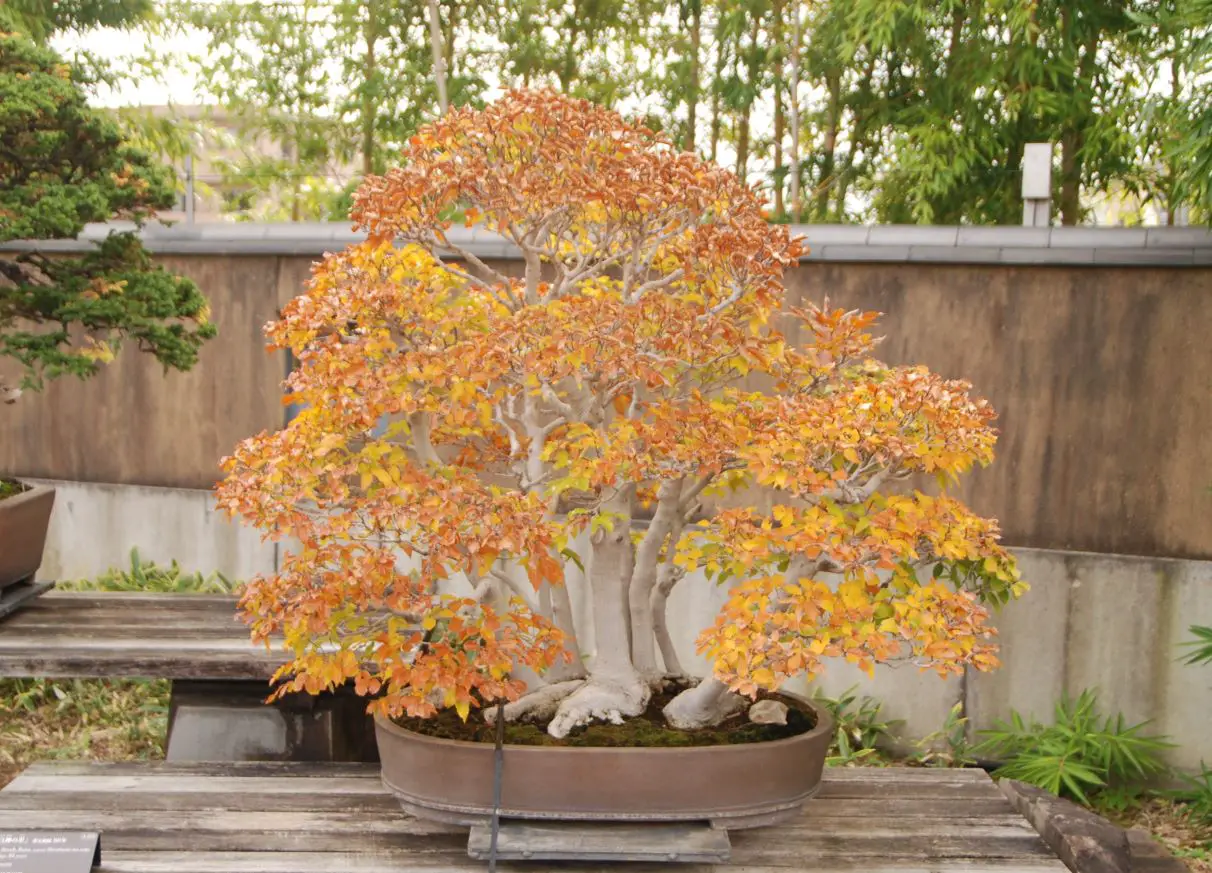Bonsai does not have to be trees. While tree bonsai is more prevalent, there is another type of bonsai that focuses on grass and moss. Practically any plant can be bonsai as long as it appears natural and aesthetically pleasing in small pots.
Can any plant be a bonsai?
What is bonsai?
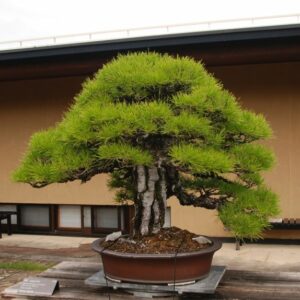
Bonsai is a Japanese art form that aims to create a natural landscape with plants in a small pot. The word “bonsai” literally translates to “plant in a pot”.
One of the most important elements of bonsai cultivation involves creating a tree that appears to be a fully-grown, mature tree in nature but in a miniature form. The process requires careful pruning and training of the tree’s trunk, branches, and roots to create a compact and aesthetically pleasing shape.
Throughout history, bonsai is influenced by Zen Buddhism with its appreciation of the simple yet imperfect beauty of nature. Bonsai may not be a “true” reflection of nature but it is something that makes you see nature while looking at it.
To know more about the zen influence on bonsai, please read the following post.
Types of plants used for bonsai
Types of bonsai
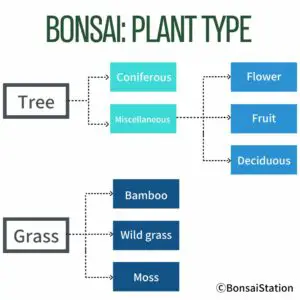
Bonsai plant type
There are 2 primary types of bonsai: tree and grass.
Tree bonsai
Tree bonsai, as the name suggests, are bonsai that are created from woody plants or shrubs. They are the most common type of bonsai and are often what people think of when they hear the term “bonsai.”
Grass bonsai
Grass bonsai, on the other hand, are bonsai that are created from non-woody plants, such as grasses, bamboo, and mosses. They are less commonly known than tree bonsai but are becoming more popular for their accessibility.
Grass bonsai is also called Kusamono bonsai, which literally means “something made of/from grass” in Japanese.
The Role of Trees in Traditional Bonsai
Trees have traditionally played a central role in bonsai cultivation. The whole concept of bonsai is to shrink the natural landscape down into a small container and trees are one of the main elements to create this miniature landscape.
To make this palm-size landscape possible, people found a way to make trees dwarfs to look like fully-grown plants in the wild. They are specially trained and pruned to create the illusion of a much larger tree.
In addition to their symbolistic qualities of nature, trees also play an important role in the spiritual aspects of bonsai.
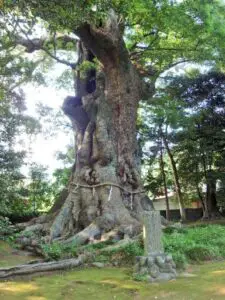
A sacred tree in a Shinto shrine. A thunder-shaped white paper is attached to the tree along with a straw rope to show its sacredness.
In Shinto shrines, a temple of the animistic Japanese religion, there are often sacred trees as an object of worship. Some Shinto shrines do not even have a physical structure (=shrine) but instead worship a sacred tree directly as the “house” where gods live. Here, we pray to trees as alternative forms of gods themselves.
Trees were therefore regarded as sacred objects, and bonsai cultivation was seen as a way to connect with the spiritual essence of nature as well.
Non-Tree Bonsai
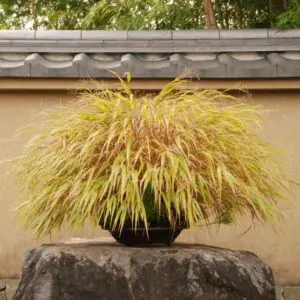
Kusamono (grass)
While trees are still the most common subjects of bonsai, modern bonsai have expanded the practice to include a wider variety of plant species: grass.
Once just a complementary element to tree bonsai display, grass bonsai, or Kusamono bonsai, has developed into a distinct type of bonsai that emphasizes the use of grass to represent nature as it is.
Some of the common types of plants used in Kusamono bonsai include grass, fern, succulent, (wild)flower, moss, and bamboo. While wild plants have customarily been used, Kusamono bonsai now allows using a vast variety of plants including human-cultivated plants that we see at gardening stores.
For more about Kusamono bonsai, the following post might be helpful.
What makes a tree suitable for tree bonsai
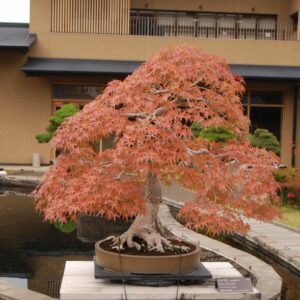
Almost any tree can be a bonsai tree as long as they have the following characteristics that make them look more natural/beautiful when they are grown to be a miniature size.
- Trees with tiny leaves
- Ramifications
- Dense foliage
- Beautiful tree bark
Small leaves
The ideal candidate for bonsai should have small leaves that are in proportion to the tree’s size. Large leaves may look out of place on a small bonsai tree and are not suitable.
Ramifications
A normal size tree normally has myriads of branches when they are mature. So, trees with the possibility of growing a lot of fine branches are a good candidate for a bonsai.
Dense foliage
In nature, a mature tree has had many years to grow and develop its branches and leaves, resulting in a dense canopy. A bonsai tree with dense foliage is able to convey this sense of age and maturity, as it appears as if it has been growing and developing for many years.
Beautiful tree bark
Whether tree bark is smooth or coarse, a good bonsai has to have a beautiful bark that can add to the overall aesthetic appeal of the bonsai.
What makes a plant suitable for Kusamono bonsai
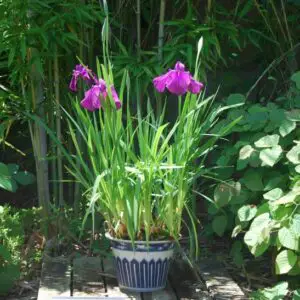
Kusamono (iris)
Seasonality
For Kusamono bonsai, it is important that they clearly show seasonality or imagery of seasons that change throughout the year.
Kusamono bonsai showcase the beauty of plants throughout the seasons. This allows the Kusamono bonsai to evoke a sense of seasonality that sometimes tree bonsai such as juniper and spruce lacks.
Natural appearance
The ability to retain their natural appearance is as important quality as the seasonality. As bonsai, Kusamono aims to represent nature and so fancy and showy varieties do not match this quality.
Plants not suitable for Kusamono
On the other hand, plants that are not suitable for Kusamono bonsai are those with thin, weak stems that cannot support the weight of themselves or flowers, and those that are not compatible with other plants growing in the same pot.
Also, plants that grow very large are unsuitable for Kusamono. Unlike trees, it is difficult to make grass into miniature size by pruning and shaping; it usually takes at least a few years, which grass does not have.

